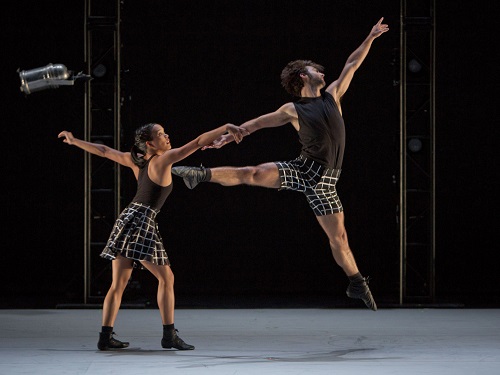 United States Various composers, Peck, Cherkaoui & Millepied (choreography): L.A. Dance Project, Wallis Annenberg Center for the Performing Arts, Beverly Hills, 29.1.2016-30.1.2016. (JRo)
United States Various composers, Peck, Cherkaoui & Millepied (choreography): L.A. Dance Project, Wallis Annenberg Center for the Performing Arts, Beverly Hills, 29.1.2016-30.1.2016. (JRo)

Photo credit: Rose Eichenbaum
Dancers: Stephanie Amurao, Aaron Carr, Julia Eichten, Morgan Lugo, Nathan Makolandra, Rachelle Rafailedes, Robbie Moore, Anthony Bryant, Lilja Ruriksdottir
Production:
Murder Ballades
Choreography: Justin Peck
Music: Bryce Dessner
Lighting: Brandon Stirling Baker
Costumes: Justin Peck
Visual Installation: Sterling Ruby
Harbor Me
Choreography: Sidi Larbi Cherkaoui
Music: Park Woojae, Geomungo “Extension”
Lighting and Visuals: Fabiana Piccioli
Hearts & Arrows
Choreography: Benjamin Millepied
Music: Philip Glass, String Quartet No. 3
Lighting: Roderick Murray
Costumes: Janie Taylor
Visual Concept: Liam Gillick
L.A. Dance Project, the company founded by Benjamin Millepied, former New York City Ballet principal and current director of the Paris Opera Ballet, takes its name from Los Angeles but spends the bulk of its time touring internationally. On its annual return to LA, the company landed at the Wallis in Beverly Hills.
This relatively new theatre has proved to be a worthy and lively venue for dance, particularly with Twyla Tharp’s 2015 visit. What was perplexing last night was the scattered and unprofessional pacing of the presentation. A sixty-minute evening of dance turned into nearly two hours, with more than forty minutes devoted to intermissions. Coupled with lackluster choreography, this had the effect of turning three short dances into a sluggish night of performances.
The program opened with Murder Ballades, a collaboration between Justin Peck and composer Bryce Dessner. Rooted in European and American folk traditions of recounting bloody murders in song, Dessner’s score (in recording) created a buoyant sound world of complex rhythms and plaintive strings. However, the music, reflecting the stoicism of the hardscrabble existence of the American heartland, was diminished by Peck’s gentle handling of this ominous material.
In the opening, repetitive choreography with arms and legs inscribing circles offered little in the way of foreshadowing the violence to come. And though the music grew more urgent as the piece progressed, the dancing did not. Only in one later section, when the dancers used their bodies like pendulums, sometimes capsizing and then reasserting themselves in an upright posture of defiance, was there a hint of conflict.
Rectangular slashes of reds, blacks, grays, and browns formed a distracting, flag-like backdrop. Inexplicably, sneakers were put on and removed, perhaps to emphasize the “American-ness” of the theme. The lighting was muddy and failed to highlight when needed.
Lighting became a significant component in Sidi Larbi Cherkaoui’s Harbor Me. On a darkened stage, shafts of light from above cut through the blackness, illuminating male dancers writhing on the floor. Are we in a prison? A mosque? Program notes suggest this is a place of shelter, and yet the dancing conveyed a sense of discomfort and disquiet. Sinking and sliding, three dancers, representing fire, water, and air, moved together like a huge caterpillar. At its best, the choreography referenced ancient mythology, as the dancers maneuvered like one organism, now attaching their heads, now their torsos. At its worst, it became a parlor game whose participants struggled to put their fingers together in order to create geometric shapes in the air. Here is where the lighting failed to add clarity. Granted, we are in a shadowy realm, but with an inordinate amount of time spent skirting the floor and the continual entangling of bodies, it became difficult to delineate movement.
It was a welcome relief to see the stage lit up for Benjamin Millepied’s Hearts & Arrows. The costumes seemed ragged and slapdash in the preceding dances, but they glowed with stylish effervescence in Hearts & Arrows, with skirts for the women and shorts for the men patterned in glorious black and white. With his usual elegance, Millepied moved his dancers in pleasing patterns as they sauntered through a catalogue of jumps, spins, and lifts.
Most engaging was the final section of Glass’s score when the dancers linked arms and bodies in a circle and moved in harmony. But Glass’s music, so ubiquitous in dance, had no inherent relationship to the choreography. Over and over again, choreographers use his music, one assumes for the ease and compatibility of creating dance to its repetitive structures. But it is with Lucinda Childs that Glass’s compositions achieve true impact in dance. With her uncanny ability to uncover complex patterns within minimalist movements, she truly embraces Glass’s sensibility.
Nowhere in Millepied’s amiable dance vocabulary was there an exploration of the music or the intellectual rigor to justify yet another dance created to Glass’s distinctive sound world.
Jane Rosenberg
